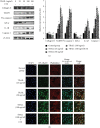Moderate Mechanical Stimulation Protects Rats against Osteoarthritis through the Regulation of TRAIL via the NF- κ B/NLRP3 Pathway
- PMID: 32566090
- PMCID: PMC7267856
- DOI: 10.1155/2020/6196398
Moderate Mechanical Stimulation Protects Rats against Osteoarthritis through the Regulation of TRAIL via the NF- κ B/NLRP3 Pathway
Abstract
The aim of this study was to examine exercise-related genes in articular cartilage identified through bioinformatics analysis to dissect the potential signaling pathway involved in mechanical stimulation in osteoarthritis (OA). To this end, we evaluated the GSE74898 dataset from the Gene Expression Omnibus database for exercise-related differentially expressed miRNAs (DE-miRNAs) using the R software package and predicted potential target genes for these miRNAs using miRTarBase. Functional annotation and pathway enrichment analysis were performed for these potential DE-miRNA targets. The effects of mechanical stimulation on the tumor necrosis factor-related apoptosis-induced ligand (TRAIL)/nuclear factor-kappa B (NF-κB)/nucleotide-binding and oligomerization domain-like receptor containing protein 3 (NLRP3) signaling pathway were evaluated in articular cartilage and chondrocytes. A total of 394 DE-miRNAs were identified (103 upregulated miRNAs; 291 downregulated miRNAs) in the cartilage of rats following treadmill exercise compared to the cartilage of unexercised control rats. Thus, mechanical stimulation could modulate the TRAIL/NF-κB/NLRP3 signaling pathway on OA. Histological and protein analysis demonstrated that moderate-intensity treadmill exercise could ameliorate OA through the downregulation of TRAIL. Furthermore, moderate cyclic tensile strain (CTS) could rescue chondrocytes from the effects of TRAIL via the inhibition of the nuclear translocation of NF-κB p65 and formation of NLRP3. Our findings indicate that moderate mechanical stimulation could ameliorate the degeneration of cartilage and chondrocyte damage through the inhibition of the TRAIL/NF-κB/NLRP3 pathway.
Copyright © 2020 Yue Yang et al.
Conflict of interest statement
The authors have declared that no competing interests exist.
Figures






References
MeSH terms
Substances
LinkOut - more resources
Full Text Sources
Medical
Research Materials

